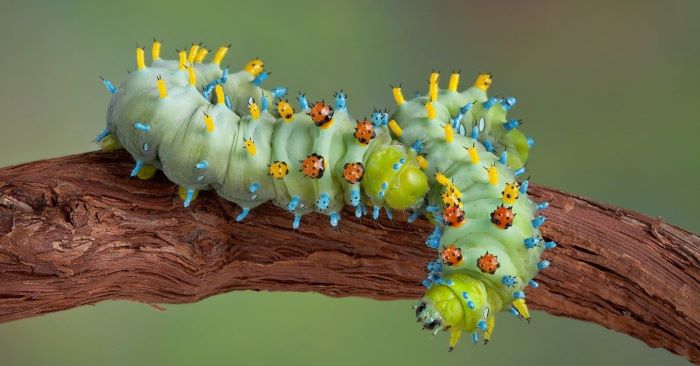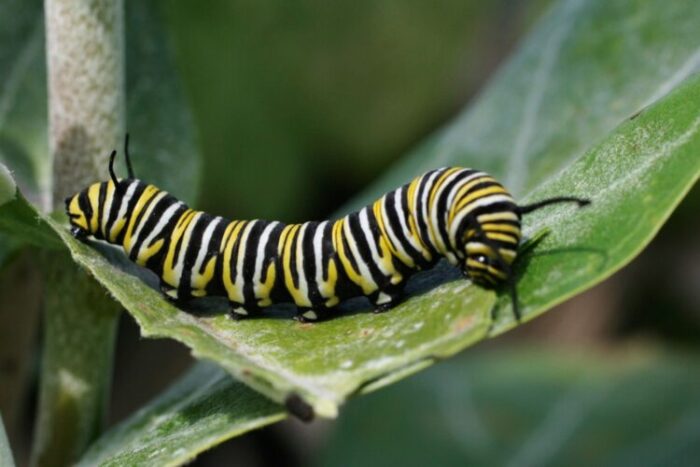Caterpillars, the larval stage of butterflies and moths, are truly fascinating creatures. As they munch their way through leaves before forming a chrysalis and transforming into winged adults, caterpillars display an array of curious behaviors and adaptations. In this article we talk about 10 Unusual Facts About Caterpillars.
Table of Contents
Caterpillar Families Can Be Huge

A single female moth can lay hundreds or even thousands of eggs at a time. For example, a female gypsy moth can produce 500-1,000 eggs over a couple of weeks. If most of those caterpillars survive, that’s a lot of hungry mouths to feed! This helps explain why caterpillars are such voracious eaters. They need all that energy to fuel their numerous siblings.
Some Caterpillars Use Their Old Skins as Camouflage
As they grow, caterpillars must regularly shed their exoskeleton in a process called molting. Many species simply discard their old head capsules and skins, but others have found ingenious uses for these leftover bits. For example, hawk moth caterpillars will collect their old skins and fix them to the horns on their backs using silk. This makes them look bigger and resembles snake scales, helping to deter potential predators.
Caterpillars Can Travel Over a Mile to Pupate
When it’s time to transition into the pupal stage, some caterpillars exhibit interesting migratory behaviors. Species like the monarch butterfly are known to travel long distances of over a mile before choosing a suitable spot to pupate. This may help them find locations that are more protected from predators and severe weather. Their ability to delay metamorphosis for long enough to travel such lengths is quite impressive.
Bird Droppings Camouflage Helps Caterpillars Avoid Predation
Many caterpillars have striking camouflage to help them blend into plants and avoid hungry birds and other predators. One unusual example is the hawk moth hornworm, which will affix pieces of its own frass (caterpillar poop) to a horn on its back. This makes it resemble bird droppings, which animals usually avoid eating. This is an ingenious evolutionary adaptation!
Some Tropical Caterpillars Are Highly Venomous
While most caterpillars are harmless, some species found in tropical regions have extremely painful stings or bites as a form of defense. For example, the saddleback caterpillar has spines filled with toxic chemicals that can cause severe irritation, rashes, nausea, and sometimes even respiratory distress or seizures in humans. So it’s wise not to touch caterpillars unless you know the species is safe!
Gypsy Moth
Gypsy Moth Caterpillars Use Airborne Pheromones to Coordinate Feeding Gypsy moth caterpillars are notorious for devastating forests and crops when their populations spike out of control. Researchers have found these caterpillars use airborne chemical signals called pheromones to communicate and synchronize their feeding in swarms. Understanding this complex social behavior may help scientists develop new pest control methods in the future.
Some Caterpillars Can Shoot Acid from Their Heads
When threatened, the larval forms of some moths and butterflies can fire jets of acidic liquid from openings behind their heads with surprising force. Species like tiger moths aim this noxious spray at the face and eyes of predators to deter attacks. It’s an unusual and effective defense mechanism!
Collective Caterpillar Groups Are Called an Army
Given their propensity to completely defoliate plants in large groups, it’s fitting that a collective of caterpillars is called an “army.” The term dates back centuries to reflect this trait. Of course, not all caterpillars form armies, but when conditions are right for huge population surges in species like the gypsy moth, foresters and farmers face a voracious onslaught.
Caterpillars Can Travel Using Ballooning Behaviors
While they lack wings before transforming into butterflies or moths, that doesn’t stop some clever caterpillar species from traveling significant distances. By climbing to vantage points, producing silk threads, and ballooning on gusts of wind, tree-dwelling caterpillars can parachute to new feeding grounds sometimes a mile or more away. It’s a risky but effective means of migration.
Some Tropical Caterpillars Are Bioluminescent
In tropical regions like Brazil, there are caterpillars in the Megathymidae family that evolved the amazing ability to glow bright green! They have paired spots on their bodies that contain luciferin and luciferase enzymes, allowing them to control bioluminescence signals to communicate. And recent research found their glow may also serve to attract prey like ants that they can then devour. How these caterpillars produce their living light remains a mystery that scientists are still investigating.
So in many ways, humble caterpillars are more fascinating than we often realize. Their unusual defenses, behaviors, adaptations, and diversity of forms reflect millions of years of evolution aimed at improving their chances of survival. The next time you see a caterpillar busily inching along and munching foliage, take a moment to appreciate just how unique these creatures truly are. I sincerely hope you find this “10 Unusual Facts About Caterpillars” article helpful.

With over 5+ years of experience in pest control and a PhD in Entomology, our author brings a blend of scientific knowledge and practical expertise to Pestifier.com. Passionate about creating pest-free environments, they provide effective tips and strategies for managing and preventing pest infestations. Connect on Facebook for the latest updates and insights.

